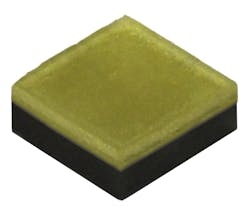Cree launches first XD-family packaged LEDs based on the NX platform
The new Cree Extreme Density LED family resembles CSP LEDs but extends lumen density significantly based on an architecture that maintains a ceramic substrate for the flip-chip design.
Cree has announced the XLamp XD16 packaged LEDs with the XD prefix indicating that the product is part of a new Extreme Density family of LEDs. The LED is based on the NX LED technology platform and Cee said it delivers lumen density of 284 lm/mm2. The XD family is essentially Cree’s answer to the chip-scale package (CSP) LED trend that essentially has a footprint that is the same size as the LED chip.
Interested in articles & announcements on packaged LEDs?
Cree had announced the NX technology platform back in April with few details and had originally suggested that the components would be commercially available by the end of the summer. Clearly it took a bit longer for the company to deliver the XD family. The NX technology platform is the successor to the SC (silicon carbide) designated platforms that topped out at SC5 and has been the basis of Cree’s newest LEDs for more than two years.
LEDs based on the SC5 platform such as the XHP (extreme high power) series top out at a lumen density around 140 lm/mm2. Most of the XHP products have been in relatively larger form factors such as 3.5×3.5, 5×5, and 7×7 mm. The XD family doubles that performance level and thereby can deliver similar lumen output from the 1.6×1.6-mm package.
Of course, lumen output varies considerably across the family based on CCT and CRI, but to provide an example of the performance, we will discuss published specifications at 3000K and 70 CRI. At 85° and a drive current of 350 mA, the packaged LEDs can deliver 148 lm, or efficacy in the 155-lm/W range. You can ramp the drive current to 1A and hit 365 lm while reducing efficacy to around 125 lm/W. The LEDs can be driven at 2A (6W) as well.
As for how the LEDs fit the application space, they seem clearly targeted at general lighting products where CSP LEDs are finding success. Cree’s marketing material did compare the devices to CSP LEDs, but the company has also been quick to point out that the packaged LEDs are high-power products based on a ceramic substrate. Still, the footprint is similar to CSP LEDs from companies such as Samsung, Seoul Semiconductor, and Lumileds.
Cree has launched a new line of packaged LEDs as part of its Extreme Density (XD) family that are capable of achieving lumen density of 284 lm/mm2.
There is no absolute definition of what constitutes a CSP LED. The idea is to minimize the packaging elements to also minimize costs. Many such LEDs consist of just the LED chip covered in phosphor-infused silicone with two electrodes added on the bottom of the devices. The chip size is slightly smaller than the overall footprint based on the phosphor material molded around the emitter.
Cree claims its architecture is superior in terms of optical and thermal performance. The architecture includes reflective structures on each side that are added in the packaging process to improve light extraction. We’ve written a number of times that many CSP LEDs emit from five sides, which can be a problem in certain applications, although manufacturers such as Samsung have also introduced CSP products with only top surface emission.
Cree product marketing manager Paul Scheidt, however, said the larger issue is that CSPs also emit downward and that as much as 28% of the produced photons are lost. The substrate on the XD16 family reflects any downward-emitted photons back toward the top surface of the LED.
As for thermals, Scheidt warns that product developers need to do a system-level thermal model to fully understand the story. CSP LEDs typically have better thermal resistance specifications because there is not the additional thermal resistance of the substrate that comes into play. But Scheidt warns there is a surface-area factor that comes into play at the system level and the ceramic substrate can enable uniform heat spreading. Moreover, the XD16 includes symmetrical contacts that are relatively larger than the contacts typically found on CSP LEDs of the same size.
Cree also believes that the XD16 packaged LEDs offer an advantage in terms of ease of manufacturing. Scheidt said CSP LEDs are easily damaged by handling equipment. He further said the LEDs can be installed with a tilt relative to the printed circuit board (PCB) or even with slight rotation, say, relative to other LEDs in an array. Scheidt admits that all of the problems can be overcome with time and care, but that the XD16 is simpler for manufacturers to deal with. Moreover, the package is similar to the Cree XQ-E LED that has been in production for several years.
Cree did not compare the XD16 in terms of performance to specific CSP LEDs. But the company did offer a graph depicting where all the CSP LEDs that are on the market stand in terms of lumen density. According to Cree, no CSP manufacturer has hit the 200-lm/mm2 mark and that many are in the 120-lm/mm2 range. We would presume the benefits of the XD16 will come at a price premium, but product developers may be able to use fewer of the packaged LEDs relative to a CSP-based design.
Cree showed some examples of the benefits of the small LEDs relative to its own high-power components. An array in a circular design with a 22-mm light-emitting surface (LES) could include 95 of the XD16 LEDs compared to 22 of the company’s XP-G3 LEDs that came to market last year. The XD16-based design could produce 11,100 lm in that form factor while the XP-G3 design would produce 2800 lm.
We asked Cree if there would be other form factors in the XD family. CSP manufacturers have products that span a range from the 1-mm per side footprint up to larger than 2 mm. Scheidt said Cree may offer other sizes but also indicated that market research makes the company believe that the XD16 footprint would be the most popular among lighting manufacturers.

Maury Wright | Editor in Chief
Maury Wright is an electronics engineer turned technology journalist, who has focused specifically on the LED & Lighting industry for the past decade. Wright first wrote for LEDs Magazine as a contractor in 2010, and took over as Editor-in-Chief in 2012. He has broad experience in technology areas ranging from microprocessors to digital media to wireless networks that he gained over 30 years in the trade press. Wright has experience running global editorial operations, such as during his tenure as worldwide editorial director of EDN Magazine, and has been instrumental in launching publication websites going back to the earliest days of the Internet. Wright has won numerous industry awards, including multiple ASBPE national awards for B2B journalism excellence, and has received finalist recognition for LEDs Magazine in the FOLIO Eddie Awards. He received a BS in electrical engineering from Auburn University.





